December 28, 2018
The Who, Where & When of Off-Site Construction Technologies
A couple weeks ago, we first posted the findings of a December survey of 300 builders regarding their attitudes towards numerous off-site housing technologies. Specifically, we asked if they plan to increase their use of any of these systems within the coming year and anticipate increasing their use in the coming 5 years. The findings helped us gauge the rate at which builders intend to pursue various off-site alternatives. For industry suppliers, knowing your potential markets is crucial for developing successful market entry and expansion strategies.
A deeper dive into the data reveals that off-site opportunities are not equally spread across geographic areas, builder types, housing types, and home price-points. Further, some off-site technologies are off to a quicker initial start, while others are poised for growth beginning a few years down the road.
Below is a system-by-system summary of what you can expect of builders who adopt these off-site solutions.
Roof Trusses
From a geographic perspective, Northeast and Midwest builders were most likely consider increasing their use of roof trusses in the coming year at 16% and 13%, respectively. The South, which has the lowest current market penetration for roof trusses (about 50%), begins to show promise in 5 years with 18% planning to increase use; this is the same rate as the Midwest but trailing the Northeast. The West stands to gain the least users of roof trusses simply because the vast majority of homes built in the West already use them.
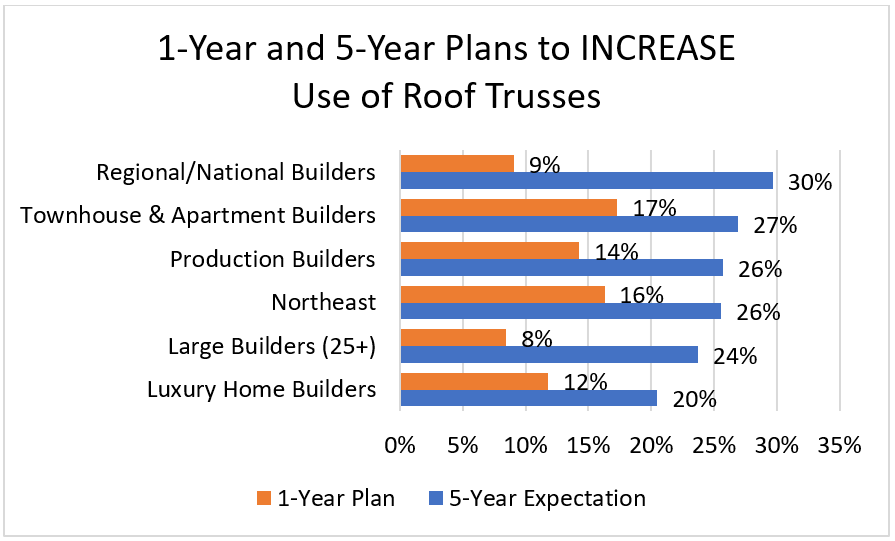
Source: Annual Builder Practices Reports, Home Innovation Research Labs
Townhouse and Multifamily sectors show highest growth potential in both one- and 5-year outlooks, with 17% and 27% planning to increase their use of trusses, respectively. Builders of luxury homes also report a higher likelihood than starter homes to switch to trusses in the future — this is interesting because luxury homes have more complex roof lines than starter homes, which would typically be a strike against using trusses, but with the current skilled labor deficit it’s getting increasingly hard to find carpenters with the skill to rafter-frame complex roofs. Production builders and those that operate Regionally or Nationally show greater likelihood of switching to trusses than those constructing Custom or Semi-custom homes and those that operate only on in a Local market.
Pre-Cut Framing Packages
This category shows substantial promise both in the coming year and 5 years out. Regionally, the Midwest is most likely to increase use of Pre-Cut Framing Packages (9% of respondents) in the coming year, and 18% five years from now. The West shows itself least inclined to adopt Pre-Cut Framing in one year (5%) but surpasses all regions but the Midwest in 5 years. Similar to trusses, Multifamily and Townhouse builders are more likely to adopt Pre-Cut Framing than Single-Family, and Luxury home builders more than Starter home builders. Builders who construct 25 homes or more per year are three times as likely to adopt this technology than smaller builders in one- and 5-year time horizons.
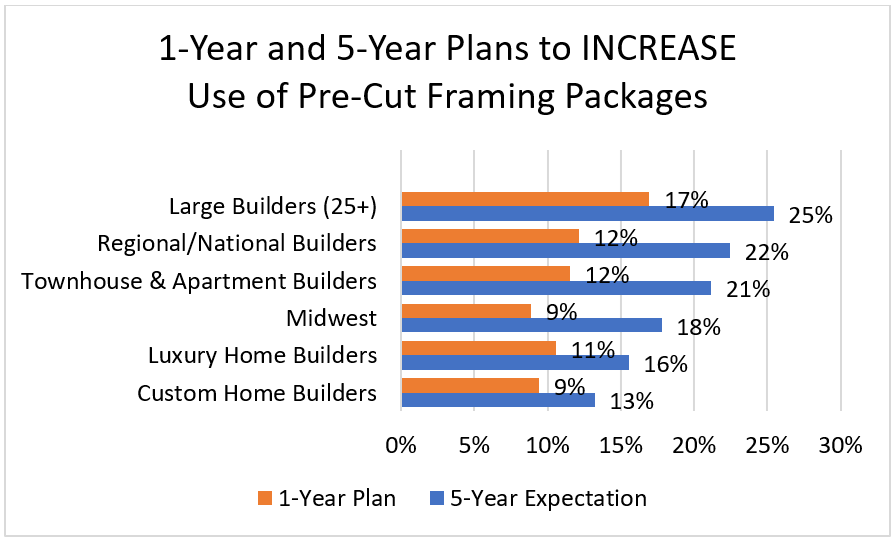
Source: Annual Builder Practices Reports, Home Innovation Research Labs
Factory-Built Open Wall Panels
Regionally, the Midwest shows the greatest promise for Factory-Built Open Wall Panels with 14% of builders planning to use more in the coming year, and 24% planning to use more within 5 years. This is more than double what’s planned by builders in the South and Northeast, and 50% higher than in the West, in both timeframes. In the one-year term, about a quarter of Townhouse and Multifamily builders plan to increase their usage, close to double what was reported by Single-Family builders. However, Townhouse and Multifamily builders switching to Wall Panels will begin to flatten within five years while Single-Family builders will continue to increase and begin to close this gap; this is particularly true for Small- and Medium-sized homes. Builders who constructed 25 homes or more in the past year reported being two-and-a-half times as likely to adopt Open Wall Panels in both one year and within 5 years compared to smaller builders. This is not a huge surprise — smaller builders are much more likely to have in-house framing crews while larger builders tend to subcontract framing installation.
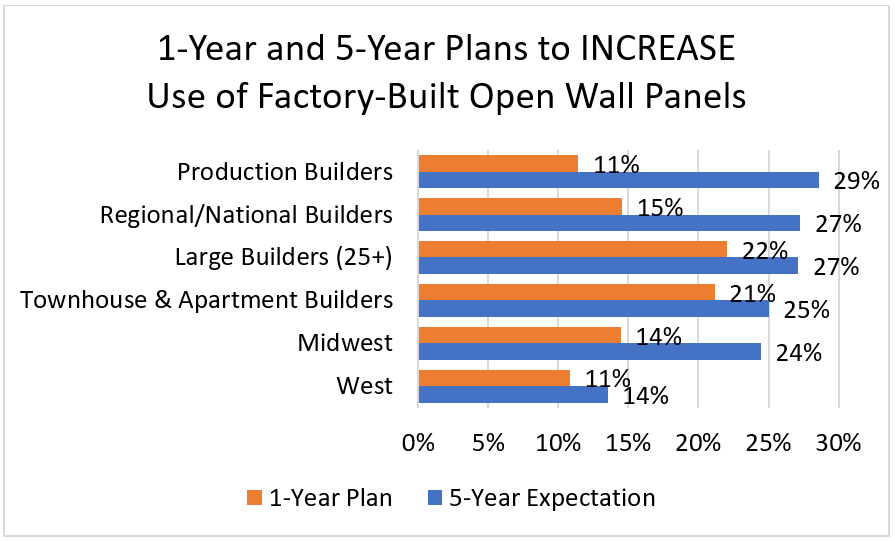
Source: Annual Builder Practices Reports, Home Innovation Research Labs
Factory-Built Closed Wall Panels
In the one-year time horizon, Northeast builders show the most promise of any region in their plan to switch to Closed Wall Panels. The Midwest and West, however, are expected to surpass the Northeast in the rate at which they move to this technology in the coming 5 years. In the short term, Townhouse and Multifamily builders are more than twice as likely to switch to Closed Wall Panels than Single-Family builders, and large builders (25+) more than double that of smaller builders. Builders who are National and Regional in scope report they are twice as likely as Local builders to switch to Closed Wall Panels.
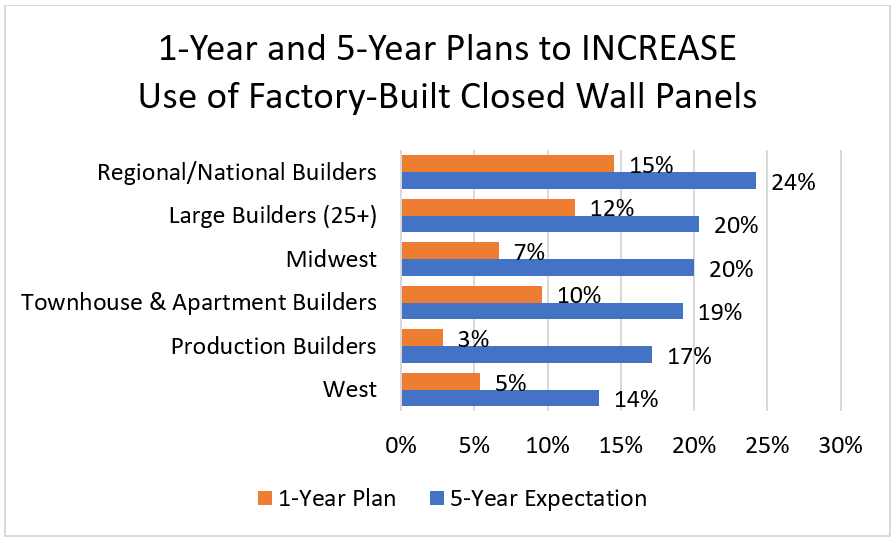
Source: Annual Builder Practices Reports, Home Innovation Research Labs
Panelized Pre-Assembled Floors
The outlook for Panelized Pre-Assembled Floors resembles that of Open Wall Panels in many ways with one primary exception — the gap between one- and 5-year expected increase in usage is much greater with Panelized Floors. This seems to indicate that adoption of Panelized Floors will lag somewhat behind that of wall panels. The Midwest seems most ready to receive this technology, and the West will follow at a somewhat slower pace. Builders in the South seem to be reluctant to adopt this method of building — likely due to the popularity of poured-in-place concrete slab foundations in that region. Like Open Wall Panels, Production builders and those constructing more than 25 homes per year are far more likely to adopt this method.
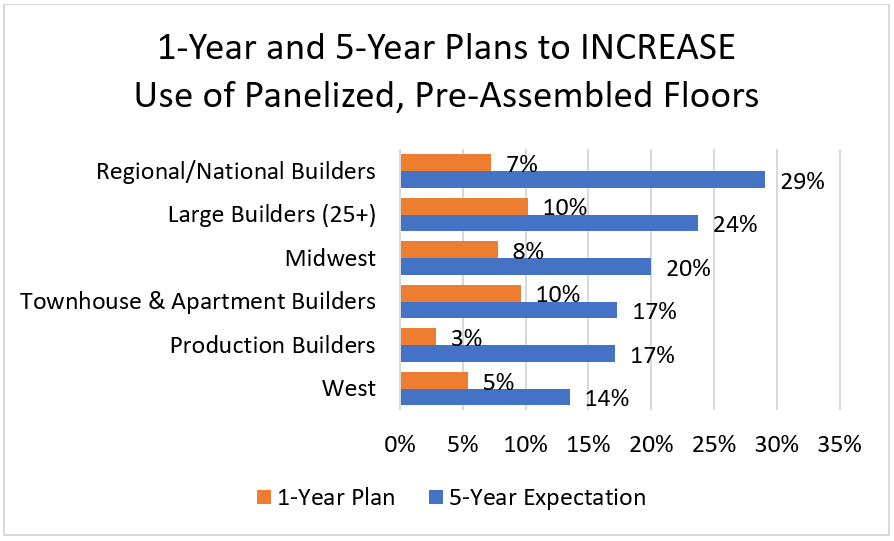
Source: Annual Builder Practices Reports, Home Innovation Research Labs
Modular Building Systems
Based on what builders told us, we can expect to see Modular housing do well among those constructing more than 25 homes per year, both in one year (8% will increase use) and 5 years (15% will increase). While Townhouse and Multifamily categories do not show immediate promise for the coming year (only 4% will increase use), they show greater promise in the 5-year timeframe (12% will increase).
There is not much difference between regions in increased demand for Modular in coming year, but for the 5-year outlook, all regions except the South begin to pick up. Unlike Wall Panels, which are favored by National and Regional builders, Modular building seems to be favored by Local Builders.
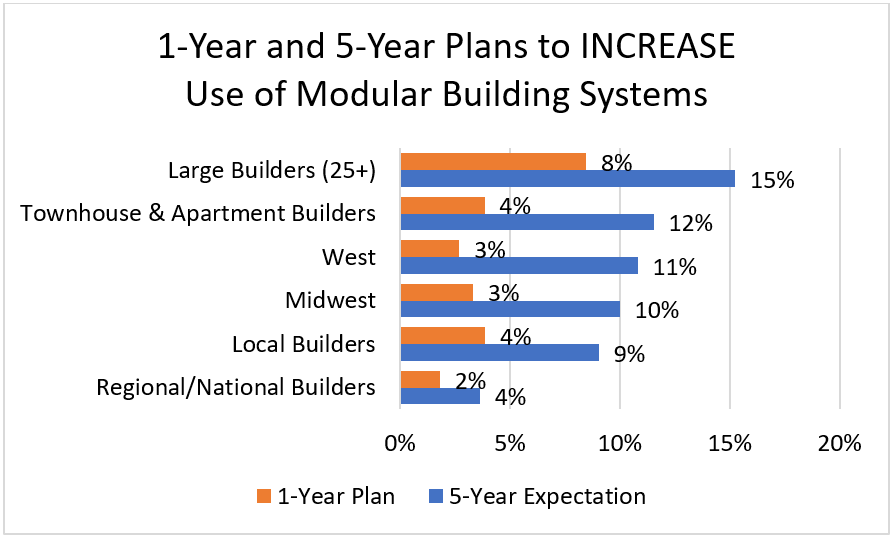
Source: Annual Builder Practices Reports, Home Innovation Research Labs
Precast Concrete Wall, Floor & Roof Panels
The 5-year market outlook is favorable for Precast Concrete Homes, perhaps more favorable than anticipated, seeming to outpace Modular. Regionally, the Northeast is ready to adopt Precast Concrete sooner, but based on builders’ responses, the Midwest will surpass the Northeast in the 5-year timeframe. Other regions catch up with the Northeast over the longer 5-year term. Larger builders are more likely adopters of precast structural systems, and Regional and National builders favor this method more than Local builders.
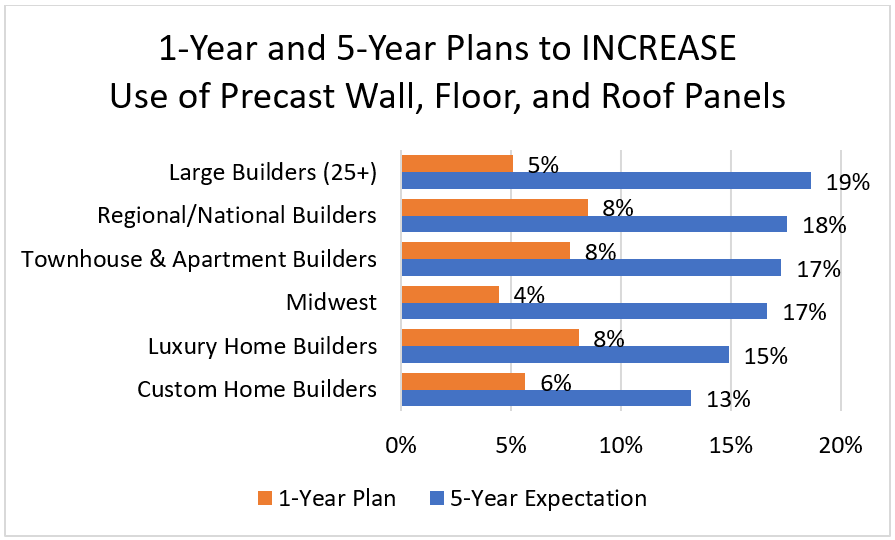
Source: Annual Builder Practices Reports, Home Innovation Research Labs
Hopefully, this information gives suppliers some broad strokes about how to plan for the coming year and the not-so-distant future for off-site building technologies. If you’re interested in the full set of tabulations from this study, contact us.
Also, in the even-less-distant future, we’re organizing now to conduct focus groups at the February 2019 International Builders’ Show in Las Vegas in February. Contact us if you would like feedback from the active, engaged industry professionals who will be attending the 2019 show. Regardless of your product type or market, you’re sure to find the respondents you need at the IBS.
Back to Top